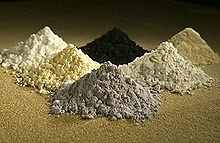Don't Worry About Rare Earths
By Dana Blankenhorn | January 19, 2011

One of the latest objections to solar energy is the “Rare Earth” argument.
Like many computer products, from which solar panel technology is loosely derived, solar energy systems often contain Rare Earths. There are 17 elements classified as Rare Earths. Rare Earths aren't really rare. It's just rare to find them in commercial-grade ore.
China has lots of Rare Earths, and as part of its export-oriented economic policy it has been keen to export them. Until recently. Suddenly, for a variety of reasons (it's dirty work mining it, domestic demand is soaring, they want better prices) China is cutting back its exports in this area. This has western analysts groaning, since China was allowed to gain a near-monopoly on this stuff because prices were so low.
In fact, as noted, Rare Earths aren't that rare at all. They're in 14 states, although currently only Molycorp of California has approvals needed to open a mine, in the Mojave Desert. Knowing where its potential market lies, Molycorp now calls Rare Earths “Green Elements”. Doesn't make them any cleaner to dig up and process, but it sounds sweet.
What we have here is a needless panic, created by a short-term market anomaly, intended mainly to discourage green investing. And, as you'll note at the top, wholly unnecessary.
Because researchers are already working hard on making Rare Earths redundant. Matt Law at the University of California in Irvine has already done research indicating iron pyrite, sometimes called “fool's gold,” may be able to replace Rare Earths in many green applications.
Law's solution isn't free. He proposes processing the metal into nanocrystals. And its future is uncertain. The efficacy of this isn't proven yet.
But, again, Law's is not the only lab working on the problem.
What gives me confidence for American leadership in solar energy is the fact that this is a fast-moving area, that we have the best labs and that we have imported some of the best minds in the world to run them (including Chinese minds).
Many of our research institutions have developed systems designed to speed research from the lab to the field, and on to the market. No matter how many engineers or entrepreneurs China has, it can't yet match our incentives, our research environment, our venture capital networks, or the speed with which we can get from lab to market.
Is that a guarantee? No. But I'm placing my bet on America, and you should too.
Comment:
Actually, China has been making threats about exporting rare
earth products for many years. This is not really anything new. It's
new in the context of renewable energy, where China wants to get a
leg up.
By limiting rare earths to companies setting up business in China,
they hope to lure more business. With about 97% of rare earth
exports, China is by far the biggest player here. It would seem to
me that this IS something we should be concerned about.
And we're not talking just solar, here. We're talking all kinds of
energy technologies that demand rare metals.
I do, however, think you're right about other countries stepping up.
America, Australia and (more recently Afghanistan) have significant
resources. Despite exporting 97% of rare earths, China only has a
third of the resources....
No matter which way you slice it, this will be a very touchy
political issue moving forward.
Stephan Lacey
 To subscribe or visit go to:
http://www.renewableenergyaccess.com
To subscribe or visit go to:
http://www.renewableenergyaccess.com